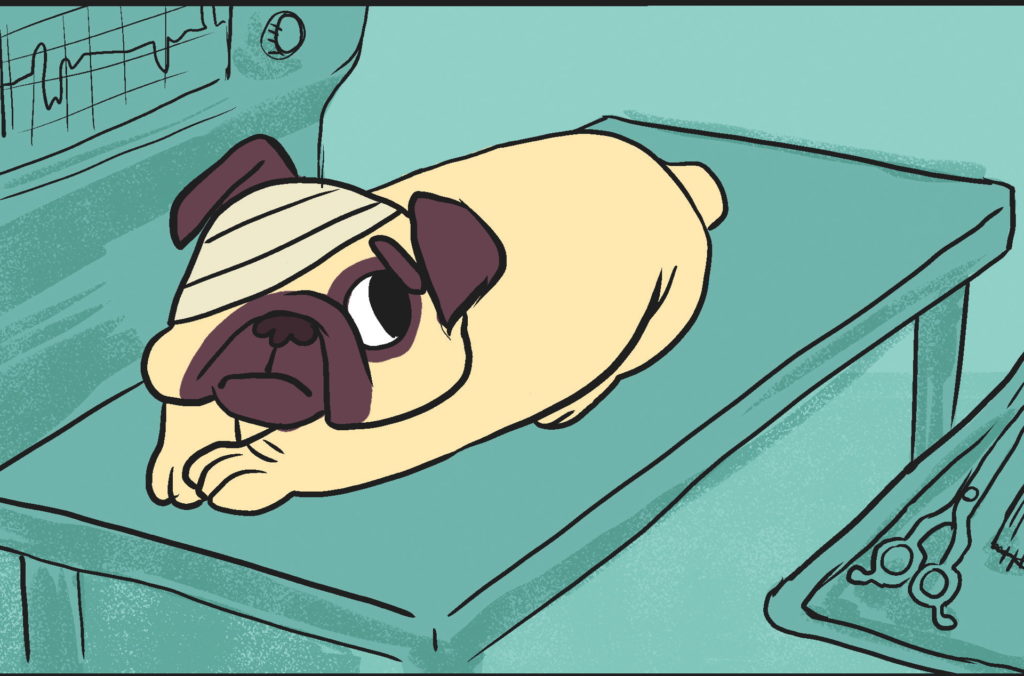Worst in breed
They're the celebrity and hipster dog of the moment.
But the cute features of the pug mask breathing problems, skin irritations and weak immune systems
From Paris Hilton to Jessica Alba, pugs seem to have captured the imagination of a generation of celebrities – and their fans. From London to Liverpool, from Preston to Paris, it’s impossible to walk through cities without encountering the bounding, slobbering little beasts. Along with French bulldogs, pugs and their compacted, exaggerated features can be spotted on the streets of every smalltown.
The breeds’ distinctive features – a snout typically 80 per cent shorter than other dogs, big round eyes and a broad face – make it hard not to be charmed. But these apparently endearing symptoms are actually signs of deep-seated anatomical problems that have prompted many vets to speak out against the popularity of such breeds. Brachycephalic dogs – including pugs, French bulldogs and English bulldogs – are plagued by a string of congenital problems at the best of times but due to a rocketing popularity unscrupulous breeders are making matters worse.
The cute grunts and snorts? They’re a sign of a breed struggling to breathe because of an overly engineered appearance. This is a key sign of brachycephalic obstructive airway syndrome (BOAS) – a condition inherent in short snouted breeds, with many young pups requiring extensive surgery within months of being born. Although a short snout may not seem problematic, it contains the same amount of tissue as a standard snouted breed, such as a labrador, meaning the impact of the compact tissue would be the equivalent of a human trying to breathe through a drinking straw.
Gudrun Ravetz, a president of the British Veterinary Association and a small animal specialist based in Cumbria, says: “Every day our members are treating brachycephalic dogs, including pugs, French bulldogs and British bulldogs, that have breed-related health and welfare problems. So it’s not just pugs we are worried about.
“The health issues with brachycephalic breeds have become more prominent as these breeds have grown so rapidly in popularity over the last few years. Prospective dog owners need to consider that these dogs can suffer a range of health issues throughout their lives, from eye ulcers to painful spine abnormalities and severe breathing difficulties that can result in otherwise preventable surgery.
“Sadly, the more exaggerated the conformation of the dog’s face, the more negative the health implications, such as difficulty breathing, skin irritations and eye problems.”
Big Issue North heard of a six-month-old pug that lost an eye due to deformities associated with abnormally shallow eye sockets. This led to an ulcer developing in the remaining eye, leaving the dog at risk going blind should it not respond to treatment.
“Potential owners should talk to their local veterinary surgeon before buying a dog.”
“We would recommend that people don’t buy brachycephalic dogs because even well-bred ones still have extreme characteristics and can struggle with health problems,” Ravetz adds.
“Potential owners should talk to their local veterinary surgeon before buying a dog as it’s a great way to better understand what may be the best breed for them, as well as learning more about how to be a responsible owner and better understand a dog’s needs.”
Many of the dogs suffer complications while under anaesthetic due to BOAS. This has led to some veterinary practices implementing a surcharge for brachycephalic breeds, with a course of medication one week before and one after any procedure. One vet tells of a 13-week old French bulldog that had suffered a build-up of mucus due to the large amount of soft tissue crammed into its skull. That had led to aspiration pneumonia, but the condition was only discovered because it had had an unconnected operation. For other dogs, the pneumonia often goes undetected.
Due to demand the number of registered pugs in Britain has risen from 3,547 in 2007 to 10,408 in 2016. The number of French bulldogs has rocketed from 692 in 2007 to 21,470 in 2016. But there are only a small number of accredited Kennel Club breeders in the UK, meaning the lucrative gap in the market has been plugged by puppy farmers and unregulated Eastern European imports.
Caroline Kisko of the Kennel Club says it is important for prospective owners to seek out accredited owners to ensure they buy dogs in the best health.
“We are only registering a small proportion of dogs – there are an awful lot being bred overseas, she says. “These dogs are probably being bred from repeat breeding on the same parents. The people don’t care what they’re producing and there are no checks.”
Lack of regulation can lead to pups being separated from the mother and being sold too young, with serious implications for long-term health due to poor immune systems.
Kisko says: “The Kennel Club don’t want to put people off buying pugs, or Frenchies, but we want them to be sensible. First of all people can discover they are not the right breed for them but just because they’ve seen one under the likes of David Beckham’s arm they decide they want one.
“If you’ve a house full of kids I’m not saying pugs don’t like rough and tumble but a mixed breed might be more used to it and be a better fit.”
But the Kennel Club is almost entirely alone in its defence of the breed. Not only do vets widely discourage people from buying the breed, so do charities including the RSPCA and the Dogs Trust. Both have seen an increase in the number of the breeds they are coming into contact with.
The Dogs Trust is concerned about the impact of apparent celebrity endorsement of the breeds.
A spokesman says: “The increased popularity of breeds such as pugs, French bulldogs and English bulldogs hasn’t been coupled with an increased public awareness about the health issues they can suffer from. Too many people mistakenly believe that the breathing sounds these breeds often make are endearing breed traits, rather than warnings of debilitating BOAS. Dogs Trust therefore wants owners to be vigilant for the signs their dog might be suffering with the condition.
“It is essential that buyers wanting a pug, French bulldog or English bulldog puppy understand the need to look beyond appealing appearances.”
Lisa Richards, an RSPCA dog behaviour expert, says: “It’s positive to see the Kennel Club acknowledging that many dogs of these breeds aren’t able to lead happy, healthy lives as family pets because of the way they’ve been bred to look.
“Now they need to take the urgent action required to help ensure that all dogs are able to enjoy the activities that we know they love. This includes committing to a review of the breed standards.
“The RSPCA believes there is still much to be done to protect the future health of dogs and that all those who breed dogs should prioritise health, welfare and temperament over appearance when choosing which animals to breed.”
As long as the pug appears on Valentine’s cards it will be difficult to argue that their exaggerated features are not to be condoned
Kisko says the Kennel Club and its members strive to ensure all dogs are happy and healthy and argues that not all vets believe brachycephalic breeds should be avoided.
But perhaps the biggest indicator of the way pugs are increasingly perceived as endearing is the amount of merchandising you can find them on. Ravetz says that as long as the pug appears on Valentine’s cards it will be difficult to argue that their exaggerated features are not to be condoned.
“Valentine’s Day is meant to be the most romantic day of the year, so giving a gift depicting a dog that can suffer serious health and welfare problems as a result of its breeding is not the message we want to give our loved ones.
“Using pictures of pugs on greetings cards and merchandise is unnecessary and only boosts the popularity of the breed further. We need to stop seeing these breeds as cute.”
So it’s perhaps best to think of the pug not as an over-eager, baby-faced beauty but instead a slobbering bug-eyed beast struggling to breathe through airways clogged with mucous. Perhaps not so cute now, eh?

Read a comic strip version of this story by Amy Evans in the 22 May edition of Big Issue North
This article has been amended to correct an error. “Although a short snout may seem problematic…” now reads “Although a short snout may[not seem problematic…”
